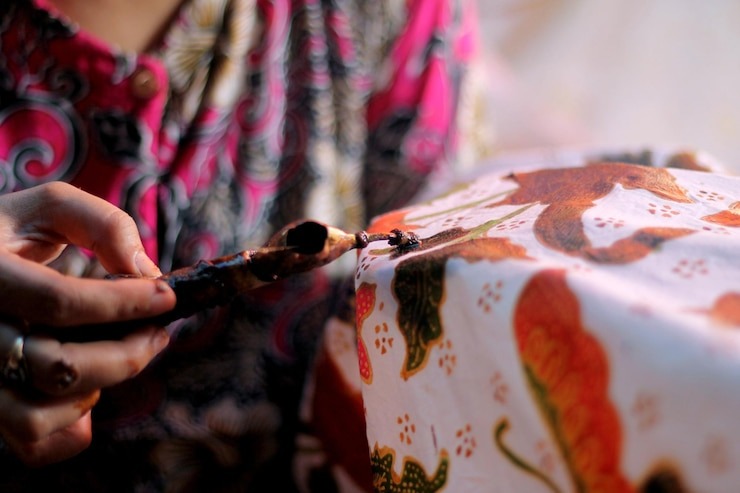
Eco-Friendly Art: The Role of Block Printing in Sustainable Fashion
In a world increasingly conscious of its environmental footprint, the fashion industry faces immense pressure to become more sustainable.1 At Adhunik Block Print, we are not just creating beautiful textiles; we are deeply committed to a future where fashion harmonizes with nature. This commitment is intrinsically woven into the very fabric of block printing, making it a powerful force in the movement towards sustainable fashion.
Join us as we explore how this ancient art form stands as a beacon of eco-friendliness in a rapidly changing world.
The Problem with Fast Fashion: A Quick Look
Before we delve into the solutions, it’s crucial to understand the challenges. The “fast fashion” model – characterized by rapid production cycles, cheap materials, and disposable trends – has significant environmental and social costs:2
- Excessive Water Use: Growing conventional cotton and dyeing processes consume vast amounts of water.3
- Chemical Pollution: Synthetic dyes and finishing agents release toxic chemicals into waterways.4
- High Energy Consumption: Manufacturing and global transportation contribute to carbon emissions.5
- Waste Generation: Landfills overflow with discarded garments, many containing non-biodegradable synthetic fibers.6
- Poor Labor Practices: The drive for low costs often compromises worker welfare.7
Block Printing: A Pillar of Sustainable Practices
In stark contrast to the unsustainable practices of fast fashion, traditional block printing, especially as practiced by ethical brands like Adhunik Block Print, embodies numerous eco-friendly principles:8
1. Minimal Water Consumption:
- Targeted Dye Application: Unlike industrial dyeing processes that immerse vast quantities of fabric in dye baths, block printing applies ink precisely to the fabric’s surface. This significantly reduces the overall water needed for dyeing.
- Reduced Rinsing: The post-printing rinsing requirements are often less extensive compared to large-scale dyeing operations, further conserving water.
2. Natural Dyes and Eco-Friendly Inks:
- From Nature’s Palette: Historically and often today, block printing utilizes natural dyes derived from plants, minerals, and insects.9 Think of indigo (from the indigo plant), madder (from the madder root), turmeric, pomegranate, and iron ore. These are biodegradable and non-toxic, drastically reducing water and soil pollution.
- Low-Impact Pigments: When synthetic dyes are used (for broader color ranges or specific fastness requirements), ethical block printers opt for low-impact, AZO-free pigments that meet international environmental standards and minimize chemical discharge.
3. Reduced Energy Footprint:
- Human-Powered Craft: Block printing is predominantly a manual process.10 There’s no need for large, energy-guzzling machinery found in industrial textile mills.11 The energy expended is largely human energy, making its carbon footprint significantly smaller.
- Air Drying: Fabrics are typically air-dried, harnessing natural sunlight and wind, eliminating the need for energy-intensive dryers.
4. Longevity and Durability:
- Quality Over Quantity: Block-printed textiles are often made with high-quality natural fibers and treated with care.12 The artistry involved encourages consumers to value and care for these pieces, extending their lifespan.13
- Timeless Appeal: The designs are often timeless and culturally rich, transcending fleeting trends.14 This encourages conscious consumption, moving away from a disposable mindset. When you buy a block-printed item, you’re investing in a piece that can be cherished for years, reducing the overall demand for new, quickly discarded items.
5. Supporting Local Artisans and Economies:
- Preserving Traditional Skills: Block printing sustains ancient craft traditions and provides livelihoods for skilled artisans and their communities.15 This strengthens local economies and promotes cultural heritage.
- Ethical Labor: Unlike the often opaque supply chains of fast fashion, block printing operations are typically smaller, allowing for greater transparency and ensuring fair wages and working conditions for the artisans.16
6. Minimal Waste Production:
- Precise Application: The nature of block printing means less dye waste compared to vat dyeing.
- Handcrafted Efficiency: Artisans work efficiently, often reusing materials where possible and minimizing fabric scraps.17
Adhunik Block Print: Our Commitment to a Greener Future
At Adhunik Block Print, sustainability isn’t just a buzzword; it’s the core of our philosophy. We actively integrate these eco-friendly practices into every step of our process:
- Sourcing Organic and Natural Fibers: We prioritize fabrics like organic cotton and linen, minimizing the environmental impact of raw material production.
- Utilizing Natural and AZO-Free Dyes: We choose dyes that are safe for the environment and our artisans.
- Celebrating Handcrafted Processes: We rely on the skill and artistry of our printmakers, honoring the human element and reducing reliance on machinery.18
- Promoting Conscious Consumption: We create pieces designed to be loved and worn for years, encouraging mindful purchasing decisions.
Choosing block-printed fashion is more than just a style statement; it’s a conscious choice to support sustainable practices, ethical production, and the preservation of a beautiful, eco-friendly art form. It’s a testament to the power of tradition to shape a better, greener future for fashion.
Embrace the artistry and sustainability of Adhunik Block Print, and become a part of the movement towards a more responsible and beautiful world.
